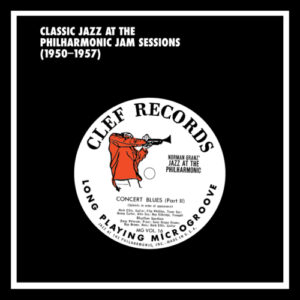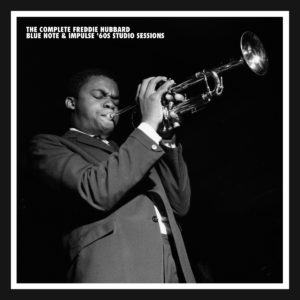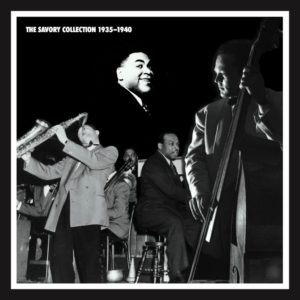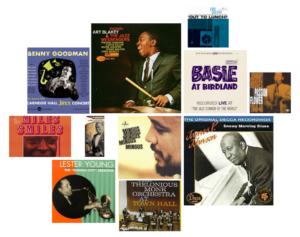The Sonny Clark set is currently on backorder and
is expected back in stock July/August.
“Sonny Clark’s music, in one of jazz’s truly magical periods, provides as good an example as any of both the music’s most lasting qualities and its transcendent nature.”

The Complete Sonny Clark
Blue Note Sessions
It’s impossible to sum up Sonny Clark’s music as sounding like the music of one player or another without adding a “but” to the description, including appreciative words about one component or another of his playing that was his alone.
Yes, he could match the speed and rhythmic inventiveness of Powell, but added a lyrical effortlessness that was never Powell’s. In a hard bop vein, he could recall Horace Silver, but Clark was groovier and more buoyant. When Clark would give voice to his bluesy side – as he did on two dates focusing on shorter-length singles for the jukebox market – he was matchless.
The extended solos of his trio work revealed what was frequently a horn-like and fluid approach to playing, sometimes catching him discover, become fascinated with, and deeply explore a new harmonic or rhythmic idiom, without ever abandoning his natural instinct to swing.
His “Sonny Clark Trio” date from October of 1957 is undoubtedly one of the best examples anywhere, from anyone, of how piano, bass, and drums can work together to create as satisfying a musical experience you could hope to find. Clark’s ensemble dates are easy evidence of why he was so often chosen to occupy the piano bench.
It’s hard to imagine a more careful, thoughtful, and supportive teammate, always listening, always filling holes, always economically moving a tune forward with just the right beam of light.
Even in his last session for Blue Note in 1962, regardless of what his lifestyle was doing to his life, his musical instincts were sharp, critical, challenging and lively, proving good support isn’t just welcome, it’s indispensable. The album of that session, “Leapin’ And Lopin,’” is on at least one list of the most essential albums from 1945 to 1970, and justly so.
Saxophonist Johnny Griffin singled him out for his attack on the instrument that recalled Bud Powell’s, but lauded Clark for his finesse and exceptional technique. Dexter Gordon said Clark was his favorite piano accompanist. If you need any other proof of how highly he was regarded, his memorial service included performances by Thelonious Monk and Jackie McLean.
Looking Straight into the
Heart of Blue Note Records





© Photographs by Francis Wolff
Nine Classic Studio Albums on Six CDs!
This limited edition set features Hank Mobley, Art Farmer, Jackie McLean, John Coltrane, Paul Chambers and Philly Joe Jones (pictured above). As well as Donald Byrd, Kenny Dorham, Clifford Jordan, Kenny Burrell, Art Blakey, and more from Blue Note’s stable of artists in a variety of settings including trio, quintet, and sextet.
Astonishing Audio Quality
Mastered from hi-res files of the original analog masters by Andreas Meyer. Thanks to current 24 bit/192 hKz technology and dramatic improvement in analog to digital converters, the sound on this set is far superior to any previous CD issues and is astonishingly close to that of audiophile vinyl.
The Complete Sonny Clark Blue Note Sessions includes 61 original tracks and alternates on six CDs. It is by far the best this music has sounded in the CD era, thanks to better analogue-to-digital transfer technology and higher resolution than was available when the music first started getting reissued twenty-five-or-so years after it was recorded.
Essay and Track-By-Track Analysis
This limited edition box set includes our deluxe Mosaic booklet featuring a complete discography, plus an essay and track-by-track analysis by Bob Blumenthal. Bob Blumenthal has been writing jazz criticism since 1969 and has contributed to numerous publications. He has received Grammy Awards for Best Album Notes and the Jazz Journalists Association’s Excellence in Newspaper, Magazine, or Online Feature or Review Writing Award and Jazz Journalism Lifetime Achievement Award.
Stunning Photographs
At Blue Note recording sessions in the ’50s and ’60s, Francis Wolff was building an archive of great photographic value and a visual documentation of jazz history unmatched at any other record company. His ability to light, frame and capture a shot was astonishing. The 11″ x 11″ full sized booklet showcases many superb Francis Wolff photos from the actual sessions courtesy of Blue Note records.
Selected Audio Clips
Bob Blumenthal, liner note excerpts

Album: Sonny’s Crib
Audio Clip: Speak Low
The weeks between Clark’s first two Blue Note albums found him in support of Curtis Fuller and alto saxophonist John Jenkins as well as a return appearance with Hank Mobley. Among the standout tracks from these dates are “Nita’s Waltz” from Fuller’s session, where the pianist plays fascinating running lines against the theme, and “Don’t Get Too Hip” from the Mobley date that includes outstanding blues choruses from Clark and Kenny Dorham as well as the leader.
The master of “Speak Low”, with John Coltrane’s cry the perfect lead voice, plus two features that make it among this listener’s favorite Sonny Clark tracks. First, there is Coltrane moving into the bridge during his solo chorus where the main theme should be repeated, then correcting himself with barely any hesitation; then there is the Clark chorus, edited in from the alternate take, that is an absolute masterpiece of rhythmic acuity and melodic invention.

Album: Sonny Clark Trio
Audio Clip: Be-Bop
If frequency of recording is any indication, the piano was producer Alfred Lion’s favorite instrument. Thelonious Monk was the beneficiary in the ‘40s, and Andrew Hill was similarly favored in the ‘60s. This third album in twelve weeks puts Sonny Clark in that exalted company. It provided his first opportunity to create an entire program without horn soloists and resulted in one of the greatest examples of music for piano, bass and drums.
“Be-Bop,” one of three originals from the first flush of modern jazz, is up tempo as expected, yet Clark maintains an uncanny sense of calm. Ideas flow, with minimal left-hand punctuations that nevertheless add another dimension of textural modulation. Paul Chambers keeps the pulse focused, and his choice of bow for his solo choruses adds an appropriate edge, while Philly Joe Jones finds moments to provide telling commentary behind Clark and has his own succinct episode.

Album: Sonny Clark Quintet
Audio Clip: Minor Meeting
After a flurry of Blue Note sessions with Mobley, Johnny Griffin, Clifford Jordan, Lee Morgan and Fuller, Clark attempted to record his own fourth album in less than five months. The instrumentation, with Jordan on tenor, Kenny Burrell’s guitar in place of any brass, the pairing of Chambers and drummer Pete La Roca and more original compositions from Clark promised another notable album, but for whatever reason the attempt yielded only three releasable titles, good enough to be scheduled as part of an LP that was announced but remained unissued until it emerged in Japan twenty years later.
Minor Meeting’s plaintive character made it one of Sonny Clark’s defining titles, with an opening piano solo both glowing and thoughtful. Burrell and Jordan had each recorded with Clark previously – the guitarist on John Jenkins’s album and Jordan on his own date. They respond with succinct invention before Clark returns for a final chorus.
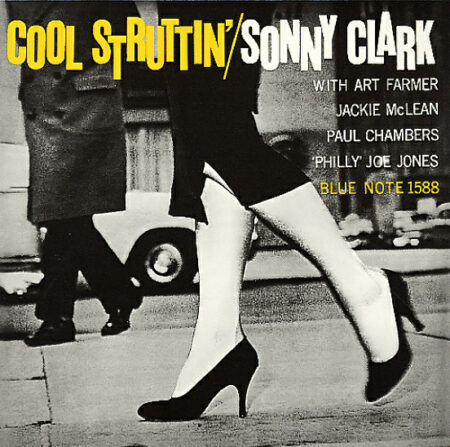
Album: Cool Struttin’
Audio Clip: Cool Struttin’
The return of Paul Chambers and Philly Joe Jones is hardly surprising, and Art Farmer was back in what proved to be his penultimate Blue Note appearance. What made the resulting music exceptional was the inclusion of alto saxophonist Jackie McLean, recently out from under his contract with Prestige. In Nat Hentoff’s original liner notes, Farmer described McLean’s sound as “like someone sticks a knife in you; you holler and scream and your voice changes in the pain. It’s a real hurt thing.” That sound, here and on three subsequent recordings under the saxophonist’s name, found an ideal partner in Sonny Clark.
As a composition, Clark’s “Cool Struttin’” is another medium-tempo blues meant to evoke in sound and title the Miles Davis “Walkin’” template. “It’s a feeling of somebody struttin’,” Clark elaborated. “The tune is a funky-modern version of an old step.”

Album: Leapin’ And Lopin’
Audio Clip: Melody For C
The quintet Clark assembled for Leapin’ and Lopin’ sounds like a first cousin to the one Monk led on his 1959 classic Five x Monk x Five. It is not simply the presence on both dates of tenor saxophonist Charlie Rouse; it is Rouse plus the richness of Tommy Turrentine’s trumpet echoing Thad Jones’s cornet, plus the wide-bottomed cymbal work of Billy Higgins reflecting the similarly deep splash of Arthur Taylor’s cymbals on the Monk volume. With Rouse, Higgins and bassist Butch Warren present, we also have a band including Monk sidemen present, past and future.
“Melody for C” finds Clark writing and playing in modal territory, demonstrating in the process an ability to sustain his personal concept even in the absence of constant harmonic motion. The relaxed elegance of Turrentine’s solo is an ideal contrast to Rouse’s greater force, and once again it is the trumpet that brings out Clark’s most vigorous accompaniment. The Warren/Higgins team remains subtly inspiring throughout, and the bassist gets a riveting chorus of his own.
Additional Albums Include


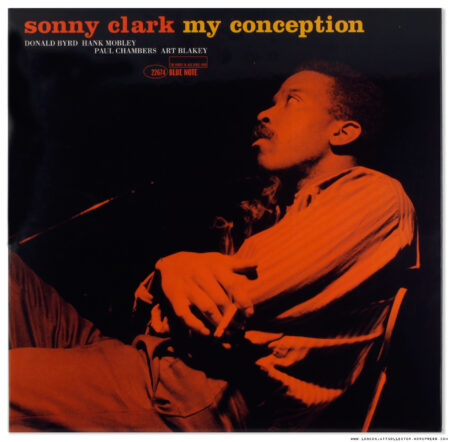

Sonny Clark
Sonny Clark grew up the last of eight kids, 20 miles east of Pittsburgh in a mining town with a “2” in the name (the mining company whose workers lived there operated two shafts. Clark’s dad, who mined coal, died from lung disease when his boy was just two months old). A photograph of his second grade class shows that Clark was the only black kid among 32 students.
He started playing piano where he was four, displaying early prowess. Clark was already performing on piano at the local black hotel when he was still in grade school and at 15, he performed at an historic “Night of the Stars” concert that featured Earl Hines, Mary Lou Williams, Billy Strayhorn, Errol Garner, Billy Eckstine, Roy Eldridge, and others.
A trip to California to visit relatives in 1951 proved momentous for the then-19 year old musician. He stayed on the West Coast for six years, working extensively with Oscar Pettiford and Wardell Gray, making his recording debut with Teddy Charles. His 1954-55 tenure with Buddy DeFranco brought him considerable exposure nationally. Known primarily as a soloist, he was schooled in comping by listening to Hampton Hawes. From then on, Clark was considered one of the most naturally sympathetic pianists in the business, making him forever in demand.
A cross-country tour in 1957 with Dinah Washington ultimately brought him to New York (a more comfortable setting musically for him than the West Coast) where he gigged with Stan Getz, Sonny Rollins, John Coltrane, Dexter Gordon, and after making his recording debut for Blue Note with Hank Mobley, almost everybody.
The surface details of Sonny Clark’s brief life are far too familiar to jazz lovers – a dependable and innovative young talent, cut down too young because of addiction. One contemporary jazz journalist expressed in 1962 the deep sorrow of witnessing “one of our jazz greats” trapped in a path that could only lead in one direction.
Alfred Lion of Blue Note first hired him on a 1957 date for Hank Mobley, and that set the stage for most of his recorded output. Including the nine dates he led for Blue Note Clark was on 22 dates between June 1957 and April 1958, and another 13 from August 1961 and October 1962. His health may have been challenged, but his musicianship was soaring.
Limited Edition: 5000
(#276- 6 CDs)
This set is strictly limited in its release and will someday be unavailable. Please don’t delay in ordering this comprehensive tribute to one of the music’s most reliably captivating artists.
The Complete Sonny Clark Blue Note Sessions
Mosaic MD6-276
Disc One:
Dial “S” For Sonny
1. Dial S For Sonny (A) 7;24
(Sonny Clark)
2. Bootin’ It (stereo take) (A) 5:13 5:15
(Sonny Clark)
3. It Could Happen To You (A) 6:56 6:58
(J. Burke-J. Van Heusen)
4. Sonny’s Mood (A) 8:36 8:37
(Sonny Clark)
5. Shoutin’ On A Riff (A) 6:42 6:44
(Sonny Clark)
6. Love Walked In (A) 5:48 5:49
(G. Gershwin-I. Gershwin)
7. Bootin’ It (mono take) (A) 5:15 5:13
(Sonny Clark)
Sonny’s Crib
8. With A Song In My Heart (B) 7:52 7:53
(R. Rodgers-L. Hart)
9. Speak Low (B) 6:47
(K. Weill-O. Nash)
10. Come Rain Or Come Shine (B) 7:25
(H. Arlen-J. Mercer)
11. Sonny’s Crib (alt tk) (B) 9:52 9:53
(Sonny Clark)
Disc Two:
Sonny’s Crib
1. Sonny’s Crib (B) 13:28
(Sonny Clark)
2. News For Lulu (B) 8:31
(Sonny Clark)
3. With A Song In My Heart (alt tk) (B) 8:45
(R. Rodgers-L. Hart)
4. Speak Low (alt tk) (B) 6:54
(k. Weill-O. Nash)
My Conception
5. Junka (H) 7:27
(Sonny Clark)
6. Blues Blue (H) 7:14
(Sonny Clark)
7. Minor Meeting (second version) (H) 6:44
(Sonny Clark)
8. Royal Flush (second version) (H) 6:58
(Sonny Clark)
9. Some Clark Bars (H) 6:16
(Sonny Clark)
10. My Conception (H) 4:43
(Sonny Clark)
Disc Three:
Sonny Clark Trio
1. Be-bop (C) 9:52
(Dizzy Gillespie)
2. I Didn’t Know What Time It Was (C) 4:20
(R. Rodgers-L. Hart)
3. Two Bass Hit (C) 3:42
(J. Lewis-D. Gillespie)
4. Tadd’s Delight (C) 6:00
(Tadd Dameron)
5. Softly As In A Morning Sunrise (C) 6:31
(S. Romberg-O. Hammerstein)
6. I’ll Remember April (C) 4:52
(DePaul-Raye-Johnston)
7. I Didn’t Know What Time It Was (alt tk) (C) 4:18
(R. Rodgers-L. Hart)
8. Two Bass Hit (alt tk) (C) 3:59
(J. Lewis-D. Gillespie)
9. Tadd’s Delight (alt tk) (C) 5:00
(Tadd Dameron)
Disc Four:
Sonny Clark Quintet
1. Minor Meeting (D) 6:51
(Sonny Clark)
2. Eastern Incident (D) 8:12
(Sonny Clark)
3. Little Sonny (D) 6:32
(Sonny Clark)
Cool Struttin’
4. Cool Struttin’ (E) 9:20
(Sonny Clark)
5. Blue Minor (E) 10:17
(Sonny Clark)
6. Sippin’ At Bell’s (E) 88:15
(Miles Davis)
7. Deep Night (E) 9:32
(C. Henderson-R. Vallee)
8. Royal Flush (E) 9:00
(Sonny Clark)
9. Lover (E) 7:00
(R. Rodgers-L. Hart)
Disc Five:
Singles Session
1. Gee Baby, Ain’t I Good To You (F) 3:57
(D. Redman-A. Razaf)
2. Ain’t No Use (F) 4:45
(S. Wyche-L. Kirklsnd)
3. I Can’t Give You Anything But Love (F) 3:48
(J. McHugh-D. Fields)
4. Black Velvet (F) 3:19
(I. Jacquet-J. Mundy)
5. I’m Just A Lucky So And So (F) 4:29
(D. Ellington-M. David)
6. The Breeze And I (F) 3:56
(Lecuona-Camarata-Stillman)
7. Gee Baby, Ain’t I Good To You (alt tk) (F) 3:49
(D. Redman-A. Razaf)
Blues in the Night
8. Blues In The Night (G) 5:53
(H. Arlen-J. Mercer)
9. Can’t We Be Friends? (G) 4:15
(K. Swift-J, Warburg)
10. Somebody Loves Me (G) 4:14
(Gershwin-DeSylva-MacDonald)
11. All Of You (G) 3:52
(Cole Porter)
12. Dancing In The Dark (G) 3:27
(A. Schwartz-H. Dietz)
13. I Cover The Waterfront (G) 4:37
(J. Green-E. Heyman)
14. Blues In The Night (alt tk) (G) 7:11
(H. Arlen-J. Mercer)
Disc Six:
Leapin’ and Lopin’
1. Something Special (I) 6:20
(Sonny Clark)
2. Deep In A Dream (I) 6:44
(J. Van Heusen-E. DeLange)
3. Melody For C (I) 7:47
(Sonny Clark)
4. Eric Walks (I) 5:39
(Butch Warren)
5. Voodoo (I) 7:38
(Sonny Clark)
6. Midnight Mambo (I) 7:12
(Tommy Turrentine)
7. Zellmar’s Delight (I) 5:40
(Sonny Clark)
8. Melody For C (alt tk) (I) 8:12
(Sonny Clark)
DISCOGRAPHY
Only the first issue of each selection is used for the purposes of this discography.
(A) DIAL ‘S’ FOR SONNY
Art Farmer, trumpet; Curtis Fuller, trombone; Hank Mobley, tenor sax; Sonny Clark, piano; Wilbur Ware, bass; Louis Hayes, drums.
Hackensack, NJ. July 21, 1957
Tk. 2 Sonny’s Mood BLP 1570
Tk. 5 Bootin’ It (stereo take) BN CD 8-56585-2
Tk. 5 Bootin’ It (mono take) BLP 1570
Tk. 8 Dial “S” For Sonny –
Tk. 11 It Could Happen To You –
Tk. 13 Shoutin’ On A Riff –
Tk. 15 Love Walked In (omit horns) –
Note: The master take of “Bootin’ It” ends just as the group is beginning to trade fours before the out theme. Apparently two takes of the insert for that take were recorded. The mono and stereo versions each use a different inset for the four-bar exchanges and closing theme. Both versions are included here.
(B) SONNY’S CRIB
Donald Byrd, trumpet; Curtis Fuller, trombone; John Coltrane, tenor sax; Sonny Clark, piano; Paul Chambers, bass; Art Taylor, drums.
Hackensack, N.J. September 1, 1957
Tk. 2 News For Lulu BST 81576
Tk. 3 Sonny’s Crib –
Tk. 4 Sonny’s Crib (alt tk) BN CD 4-97367-2
Tk. 6 Speak Low (alt tk) –
Tk. 7/6 Speak Low BST 81576
Tk. 9 With A Song In My Heart (alt tk) BN CD 4-97367-2
Tk. 10/9 With A Song In My Heart BST 81576
Tk, 12 Come Rain Or Come Shine –
Note: The master take of “Speak Low” is take 7 with the trumpet and piano solos from take 6. The master take of “With A Song In My Heart” is take 10 with the piano solo from take 9.
(C) SONNY CLARK TRIO
Sonny Clark, piano; Paul Chambers, bass; Philly Joe Jones, drums.
Hackensack, N.J. October 13, 1957
Tk. 2 I Didn’t Know What Time It Was (alt tk) GXF (J) 3069
Tk. 3 I Didn’t Know What Time It Was BST 81579
Tk. 5 Two Bass Hit –
Tk. 7 Two Bass Hit (alt tk) GXF (J) 3069
Tk. 8 Be-bop BST 81579
TK.9 Tadd’s Delight (alt tk) GXF (J) 3069
Tk. 10 Tadd’s Delight BST 81579
Tk. 11 Softly As In A Morning Sunrise –
Tk. 12 I’ll Remember April (solo p) –
(D) SONNY CLARK QUINTET
Clifford Jordan, tenor sax; Kenny Burrell, guitar; Sonny Clark, piano; Paul Chambers, bass’ Pete La Roca, drums.
Hackensack, N.J. December 8, 1957
Tk. 4 Minor Meeting LNJ (J) 70093
Tk. 6 Eastern Incident –
Tk. 10 Little Sonny –
Note: The Japanese album “Sonny Clark Quintets” LNJ 70093 was the first issue of BLP 1592, which was planned but never released by Blue Note in 1958.
(E) COOL STRUTTIN’
Art Farmer, trumpet; Jackie McLean, alto sax; Sonny Clark, piano; Paul Chambers, bass; Philly Joe Jones, drums.
Hackensack, N.J. January 5, 1958
Tk. 1 Blue Minor BST 81588
Tk. 2 Cool Struttin’ –
Tk. 4 Royal Flush LNJ (J) 70093
Tk. 5 Sippin’ At Bell’s BST 81588
Tk. 6 Deep Night –
Tk. 7 Lover LNJ (J) 70093
Note: The Japanese album “Sonny Clark Quintets” LNJ 70093 was the first issue of BLP 1592, which was planned but never released by Blue Note in 1958.
(F) SINGLES SESSION
Sonny Clark, piano; Jymie Merritt, bass; Wes Landers, drums.
Hackensack, N.J. November 15, 1958
Tk. 3 Black Velvet 45-1731
Tk. 4 I’m Just A Lucky So And So 45-1730
Tk. 5 Gee Baby, Ain’t I Good To You 45-1731
Tk. 6 Gee Baby, Ain’t I Good To You (alt tk) GXF (J) 3051
Tk. 8 Ain’t No Use 45-1730
Tk. 9 The Breeze And I 45-1729
Tk. 13 I Can’t Give You Anything But Love 45-1729
(G) BLUES IN THE NIGHT
Sonny Clark, piano; Paul Chambers, bass; Wes Landers, drums.
Hackensack, N.J. December 7, 1958
Tk. 3 Can’t We Be Friends? GXF (J) 3051
Tk. 4 I Cover The Waterfront –
Tk. 8 Somebody Loves Me –
Tk. 9 Blues In The Night –
Tk. 10 Blues In The Night (alt tk) –
Tk. 12 All Of You –
Tk. 14 Dancing In The Dark –
(H) MY CONCEPTION
Donald Byrd, trumpet; Hank Mobley, tenor sax; Sonny Clark, piano; Paul Chambers, bass; Art Blakey, drums.
Hackensack, N.J. March 29, 1959
Tk. 4 Blues Blue GXF (J) 3056
Tk. 7 Royal Flush –
Tk. 9 Junka –
Tk. 11 Minor Meeting –
Tk. 12 My Conception –
Tk. 14 Some Clark Bars –
(I) LEAPIN’ AND LOPIN’
Tommy Turrentine, trumpet; Charlie Rouse, tenor sax; Sonny Clark, piano; Butch Warren, bass; Billy Higgins, drums.
Englewood Cliffs, N.J. November 13, 1961
Tk. 5 Melody For C (alt tk) BN CD 7-84091-2
Tk. 7 Voodoo BST 84091
Tk. 11 Zellmar’s Delight BN CD 7-84091-2
Tk. 12 Somethin’ Special BST 84091
Tk. 17 Midnight Mambo –
Tk. 18 Melody For C –
Tk. 21 Eric Walks –
Ike Quebec, tenor sax replaces Turrentine and Rouse.
Same session
Tk. 24 Deep In A Dream BST 84091
Album Index:
LP
BST 81570 Dial “S” for Sonny
BST 81576 Sonny’s Crib
BST 81579 Sonny Clark Trio
BST 81588 Cool Struttin’
BST 84091 Leapin’ And Lopin’
LNJ (J) 70093 Sonny Clark Quintets
GXF (J) 3051 Blues In The Night
GXF (J) 3056 My Conception
GXF (J) 3069 The Art Of The Trio
CD
BN CD 8-56585-2 Dial “S” For Sonny
BN CD 4-97367-2 Sonny’s Crib
CD 7-84091-2 Leapin’ And Lopin’
Produced for release by Michael Cuscuna
Original sessions produced Alfred Lion
Recording engineer: Rudy Van Gelder
Mastered from hi-res files of the original analog masters by Andreas Meyer and Nancy Conforti at Swan Studios, NYC www.swanstudios.nyc
All photographs by Francis Wolff courtesy of Blue Note Records.
PRODUCER’S NOTE:
In order to keep all sessions as intact as possible, disc one ends with the first side of the “Sonny’s Crib” album followed by the alternate take of the title tune. Disc two begins with side two of the LP, followed by two alternates and the “My Conception” session out of chronological sequence. The third session “Sonny Clark Trio” could not fit on disc two in its entirety.
“Remastered to the highest standards, pressed on top-quality vinyl or CD, and sumptuously packaged, these editions are designed to please the most demanding of collectors.”
Richard Cook/Brian Morton, The Penguin Guide to Jazz


